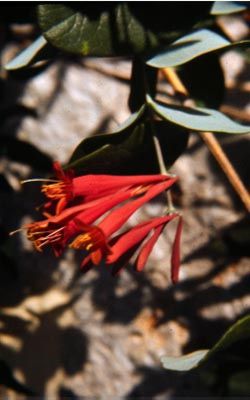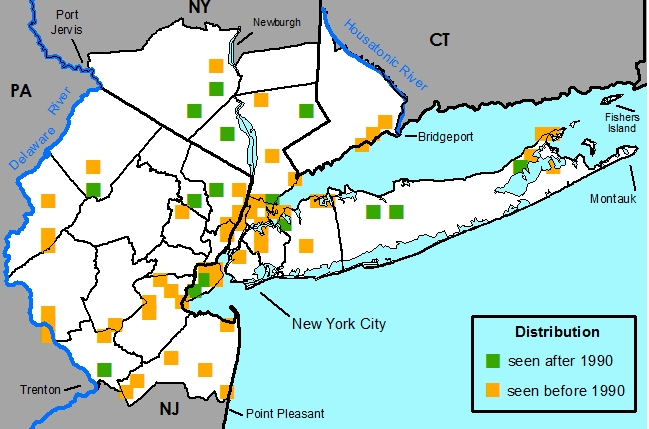Lonicera sempervirens L. - Trumpet Honeysuckle,Coral Honeysuckle,Woodbine

Photo taken bt G. A. Kalmbacher in Jamaica, NY.

Common Names
Trumpet Honeysuckle,Coral Honeysuckle,WoodbineField Identification
Woody vine with opposite, simple, entire, usually glaucous leaves; with tubular yellow-orange-red flowers at twig tips followed by orange-red berries.Other uses
(Flint, 1983) (Rehder, 1940)Often used as an ornamental planting with cultivars ranging in color from yellow to orange to red, useful for attracting hummingbirds and butterflies; introduced into cultivation about 1686 and hardy to USDA zones 3-4.
Poisonous properties
Disclaimer: The information provided here is for reference and historical use. If you believe you have been poisoned, please contact the Poison Control Office near you (look for the number in the front of the phone book).
Although the berries of some species are known to be edible; generally, ingestion of the fruit causes mild to moderate nausea, vomiting, and diarrhea; death is unlikely.
Nomenclature
*Lonicera sempervirens L., Sp. Pl. 173. 1753.Periclymenum sempervirens Miller, Dict. Gard. ed. 8, P. no. 1. 1768.
Lonicera coccinea Loddiges ex C.F. Ludwig, Neu. Wilde Baumz. 28. 1783.
?Lonicera virginica W. Young, Cat. Arb. Arbust. Am. 14. 1783.
Lonicera virginiana Marsh., Arbust. Am. 80. 1785.
Lonicera sempervirens var. major Ait., Hort. Kew 1: 230. 1789.
Lonicera sempervirens var. virginiana Castiglioni, Viaggio Stat. Un. Am. Sept. 2: 285. 1790.
Lonicera flammea Salisb., Prodr. Stirp. Chap. Allert. 138. 1796.
Lonicera sempervirens var. ovata Veillard in Duhamel, Traite Arb. Arbust. ed. augm. 1: 48. 1801.
Caprifolium sempervirens Moench, Meth. Pl. Suppl. 194. 1802.
Lonicera speciosa Wender, Index Sem. Hort. Acad. Marburg. 1827: [6]. 1827.
Periclymenum sempervirens var. latifolium Spach, Hist. Nat. Veg. Phan. 8: 345. 1839.
Phenianthus sempervirens Raf. ex Jackson, Index Kew. 2: 484. 1895.
TYPE: unknown
Description
HABIT Perennial, semi-evergreen woody vine, monoclinous, 1-3 m tall.STEMS Main stems prostrate or climbing, round. Bark smooth, not exfoliating except on oldest stems, light orange-brown or light yellowish green or gray. Twigs light yellowish green or light green, terete, 1.5-4 mm in diam., smooth, glabrous, somewhat glaucous at distal ends. Pith absent, nodal diaphragm absent. Sap translucent. For a detailed analysis of the root anatomy see Gasson, 1979. For a study of the xylem see Chiu, 1992.
BUDS Terminal and axillary present, scattered along stem; axillary buds 1-2 per axil. Bud scales light brown, imbricate, glabrous. Bud scale scars not encircling the stem. Leaf scars thinly crescent-shaped. Vascular bundle scars 3.
LEAVESOpposite, simple, spaced somewhat evenly along and divergent from stem. Stipules absent. Leaves petiolate or leaves sessile (lower leaves subsessile to short petiolate; uppermost leaves connate-perfoliate), petiole furrowed or flattened, 0.1-1 cm long, glabrous. Leaf blades: abaxial surface light green, adaxial surface green, narrow oblong or elliptic or oblong or ovate or rhombic, bilaterally symmetric, 3-8 cm long, 1-6.5 cm wide, base acute or cuneate or obtuse, with entire cartilaginous, transparent, margin. Apex acute or obtuse, mucronate. Abaxial surface glabrous or with short and unbranched appressed white hairs, sparsely or moderately densely distributed throughout. Adaxial surface glabrous, glaucous.
INFLORESCENCES Serotinous, formed on the current season's growth or formed on last season's growth, bisexual, terminal peduncled spike with 1-4 remote sessile whorls. Peduncle 2-7 cm long, usually glaucous. Rachis present. Bracts sessile, light green, margin entire, glabrous, eglandular, usually reduced lobes below each whorl; occasionally with 1 foliaceous bract subtending the lowest whorl. Bracteoles 0.
FLOWERSWith sepals and petals readily distinguishable from one another, 5-merous, usually 2-6 flowers per whorl. Calyx actinomorphic, of fused sepals, abaxial and adaxial surfaces light green, glabrous, glaucous. Sepal lobes 5, triangular or shallowly triangular, apex acute or obtuse, glabrous. Corolla actinomorphic, tubular, of fused petals, deciduous, abaxial and adaxial surfaces yellow or yellowish-orange or red or orange-red, 30-50 mm long, 10-15 mm wide. Petal lobes 5. Margin entire, apex obtuse, abaxial surface glabrous, adaxial surface glabrous. Gynoecium syncarpous. Locules 2-3. Stigmas 1, capitate. Styles 1, glabrous; slightly exerted. Ovary inferior, glabrous. Placentation axile. Androecium epipetalous, exserted, haplostemous, inserted near the top of the corolla tube. Stamens 5. Anthers opening along the long axis, yellow, glabrous. Filaments straight, light yellow, glabrous. For a detailed analysis of the flower micro-anatomy and vascularization see Wilkinson, 1948.
FRUITS Bacca, red or orange-red, globose, 6-7 mm in diameter, glabrous.
Habitat
Generally found in mesic to moist situations, such as roadside banks, woods, and thickets.Distribution
Native to eastern North America.
United States -- AL, AR, CT, DE, FL, GA, IA, IL, IN?, KS, KY, LA, MA, MD, ME, MI, MN, MS, NC, NH, NJ, NY, OH, OK, PA, RI, SC, TN, TX, VA, VT, WV
Canada -- ON?, QC?
New York Metropolitan Region -- Native throughout the metropolitan region.
Rarity Status
Heritage global rank -- G5Connecticut -- Not listed
New Jersey -- S3/S4
New York -- Not listed
Species Biology
- Flowering
- May [week 2] - July [week 3] (sporadic flowering until September)
- Pollination
- Based on L. dioica - (Graenicher, 1900)
Mellitophily? -- Andrena, Bombus, Halictus, Megachile, Osmia
Ornithophily? -- Trochilus (Hummingbird) - Fruiting
- August [week 2] - October [week 1]
- Dispersal
- (Ingold, 1983)
Endozoochory via avian frugivores: Turdus migratorius (Robin), Catharus minima (Gray-cheeked Trush), Catharus ustulatus (Swainson's Thrush), Dumetella carolinensis (Gray Catbird), Bombycilla cedorum (Cedar Waxwing), Cardinalis cardinalis (Cardinal), Carpodacus purpureus (Purple Finch), Carduelis tristis (Goldfinch), Zonotrichia albicollis (White-throated Sparrow), Mimus polyglottus (Mockingbird), Dendroica coronata?(Yellow-rumped Warbler), Toxosoma rufum? (Brown Thrasher), Cyanociita cristata? (Blue Jay)
- Germination
- (Schopmeyer, 1974)
Natural germination is believed to occur in the spring following autumn/winter dispersal. Germination is epigeous. While definite information for the optimum storage of Lonicera seeds is lacking; generally, seed stored in a sealed container at 41 degrees F should remain viable for at least one year.